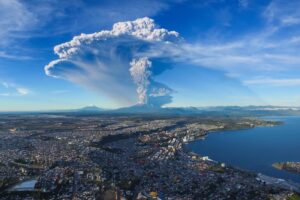Multiple Authors
05.01.2023 | 8:00am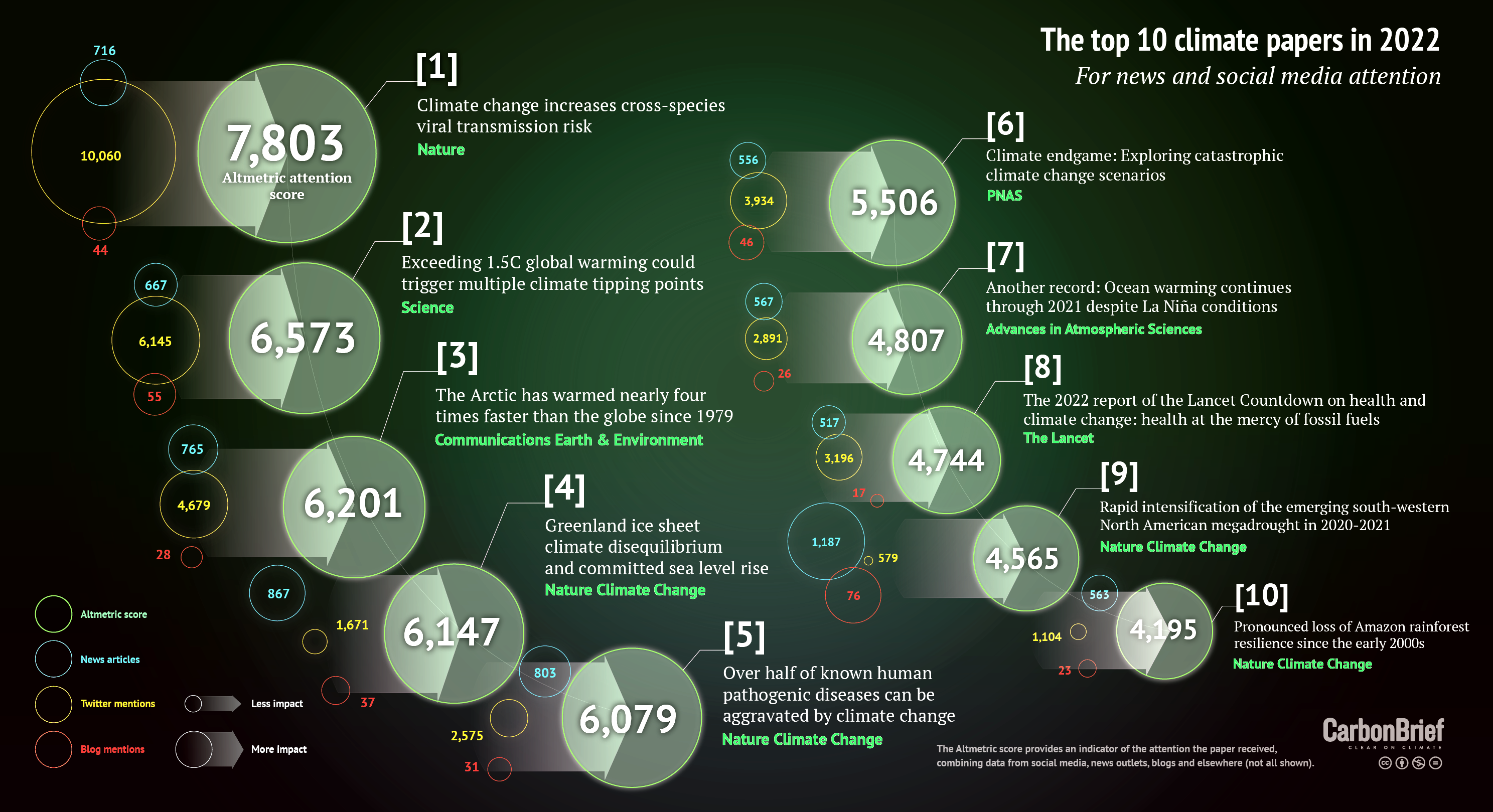
Last year brought no shortage of news. Frontpages around the world were dominated by Russia’s invasion of Ukraine, the death of Queen Elizabeth II and a UK prime minister outlasted by a lettuce.
But in yet another hectic year for news coverage, climate change still made headlines – not least because of the thousands of peer-reviewed journal papers about climate and energy that are published every year.
These studies were picked up around the world by online news outlets and shared on social media platforms, including Twitter, Facebook and LinkedIn. Tracking all these “mentions” was Altmetric, an organisation that scores academic papers according to the media attention they receive.
Using Altmetric data for 2022, Carbon Brief has compiled its now-traditional list of the 25 most talked-about climate or energy-related papers that were published the previous year.
From megafloods to megadroughts and insects to polar bears, last year saw a broad range of headline-grabbing research – as well as a new record-high Altmetric score for a paper in a Carbon Brief annual review.
The infographic above shows which papers made it into the top 10, while the chart at the end of the article shows which journals feature most frequently in the top 25.
Pandemic prominence
As in 2020 and 2021, the most talked-about scientific research of the past year has been about Covid-19.
All but five of the 50 highest scoring papers of 2022 relate to the coronavirus. Those five include two papers on monkeypox (since renamed “mpox”), one on the global burden of drug-resistant bacteria, one that identifies the Epstein-Barr virus as “the leading cause of multiple sclerosis”, and one finding that, in 2020, firearms became the main cause of deaths in children in the US.
Continuing the theme, the most talked-about climate and energy paper of 2022 also relates to the Covid-19 pandemic.
Just outside the overall top 50, in 56th place, is “Climate change increases cross-species viral transmission risk”. Published in Nature, the study warns that mammals forced to move to cooler climes amid rising global temperatures are “already” spreading their viruses further – with “undoubtable” impacts for human health.

The research uses modelling to map how climate change could shift the geographic ranges of 3,100 mammal species and the viruses they carry by 2070. It finds that climate change is increasingly driving new encounters between mammal species, raising the risk of novel disease spread. The world’s “biodiversity hotspots” and densely populated parts of Asia and Africa are most likely to be affected.
Speaking to Carbon Brief when the paper was published in April, co-lead author Dr Colin Carlson, a global change biologist at Georgetown University in Washington DC, explained:
“Species are going to show up in new combinations because of climate change and, when they do, that’s an opportunity for them to share viruses with each other.”
The relevance of the work was “reinforced by the Covid-19 pandemic”, the paper says, “which began only weeks after the completion of this study”. The authors note that Covid-19 “probably originated in south-east Asian horseshoe bats and may have spread to humans through an as-yet-unknown bridge host”. They add:
“Although we caution against over-interpreting our results as explanatory of the current pandemic, our findings suggest that climate change could easily become the dominant anthropogenic force in viral cross-species transmission, which will undoubtedly have a downstream effect on human health and pandemic risk.”
The paper clocks in with an Altmetric score of 7,803 – the highest score for any climate paper featured in Carbon Brief’s annual reviews and only the second time the top-scoring paper has surpassed 7,000.
(For Carbon Brief’s previous Altmetric articles, see the links for 2021, 2020, 2019, 2018, 2017, 2016 and 2015.)
The study was covered in 716 news stories by 558 outlets around the world, including the Guardian, New York Times, Agence France-Presse, Al Jazeera and New Delhi Times. It was also picked up in 44 blog posts.
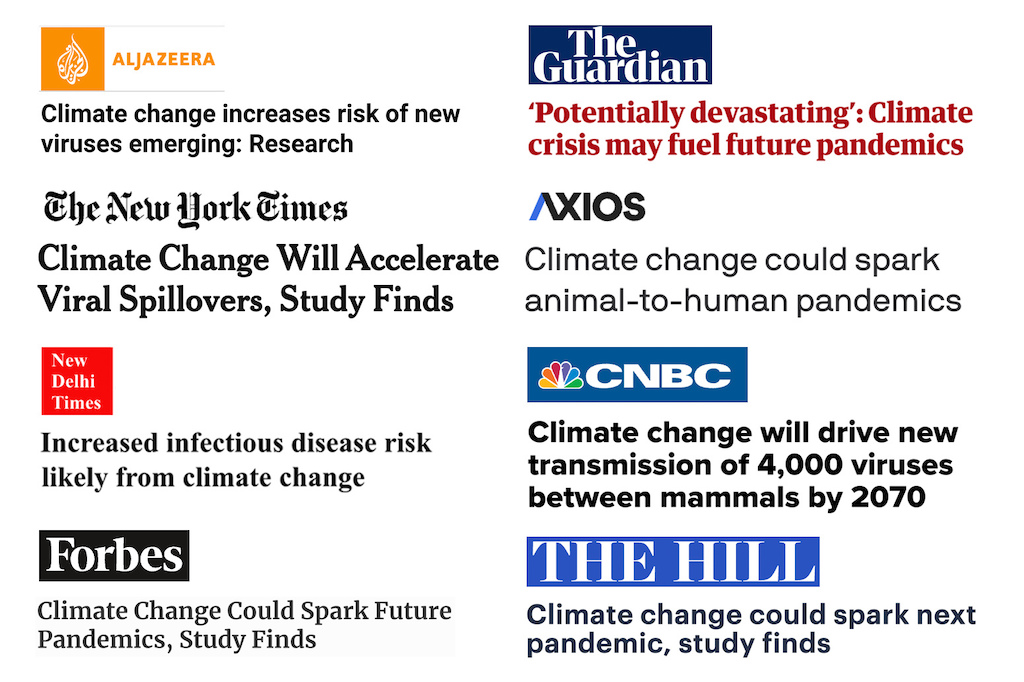
The research was the most talked about on Twitter of any of the top 25 climate papers included here. The paper’s URL was included in more than 10,000 tweets from more than 9,000 accounts, which collectively have almost 39 million followers.
Considering the paper’s timing, it is “not surprising” that connecting climate change with pandemics “gathered a bit of attention”, Carlson tells Carbon Brief.
However, he says, “there’s still a weird pattern where climate gets left out of the conversation [around pandemics] a lot compared to biodiversity loss or wildlife trade”. He adds:
“I think I’ve started to see that change finally, and if we played a part in that, that’s wonderful. Most of my work focuses on the health impacts of climate change, and I think time and time again, we underestimate how bad they’ll be…Climate change is an existential threat to human and animal health, and I hope our study and the conversation around it helped push that envelope a bit.”
Tipping points
The second highest-scoring climate paper of 2022 – clocking in at 70th in the overall 2022 rankings – is, “Exceeding 1.5C global warming could trigger multiple climate tipping points”. Published in the journal Science, the study has an Altmetric score of 6,573.

The study’s lead author, Dr David McKay, told Carbon Brief in September that tipping points have been a keen area of interest in the climate community since 2008, when the study, “Tipping elements in the Earth’s climate system”, first “broke the ice” on the subject.
His work provides the first comprehensive assessment of climate-related tipping points since the 2008 paper. It identifies 16 climate tipping elements – shown below – and finds a “significant likelihood” that multiple tipping points will be crossed if global temperatures exceed 1.5C above pre-industrial levels.
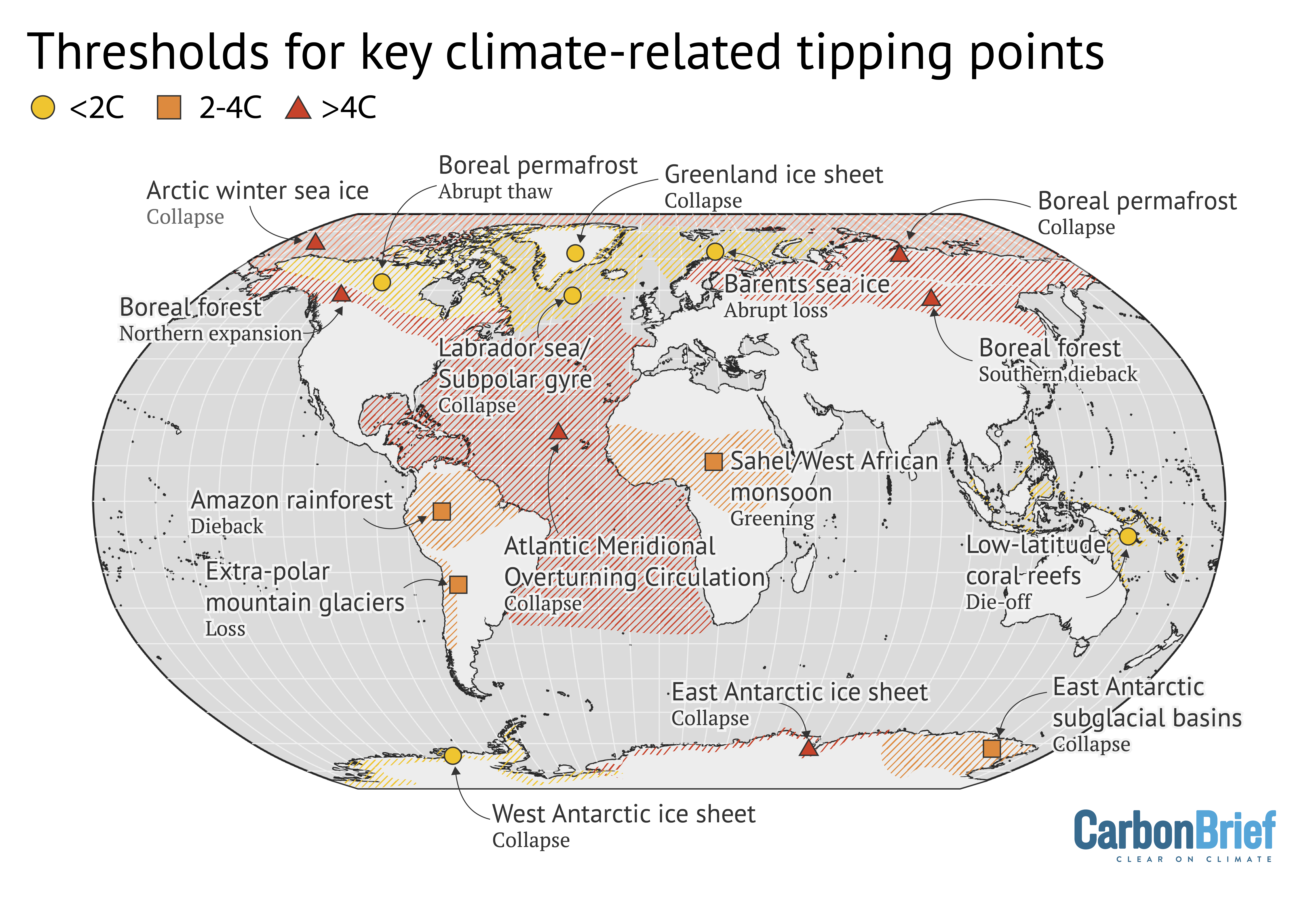
The study was mentioned in 667 news stories from 397 outlets – including the Guardian, New Scientist and BBC News. It received the highest number of mentions in blog posts and Wikipedia pages of the top 25 climate papers – at 55 and 34, respectively. The study also featured in more than 6,000 tweets.
The study was strategically published just days before researchers, economists and civil society representatives gathered in McKay’s home town of Exeter for a conference on the topic of climate tipping points. Carbon Brief attended the conference, and summarised the key talking points, ideas and proposals that emerged.
Arctic warming
In third place with an Altmetric score of 6,201 is the Communications Earth and Environment study, “The Arctic has warmed nearly four times faster than the globe since 1979”.
It is well known that Arctic temperatures are rising much faster than the global average. Previous estimates suggest that the region is warming twice or even three times as quickly as the rest of the world. However, this new study finds that the Arctic has warmed nearly four times faster than the global average over the past four decades.
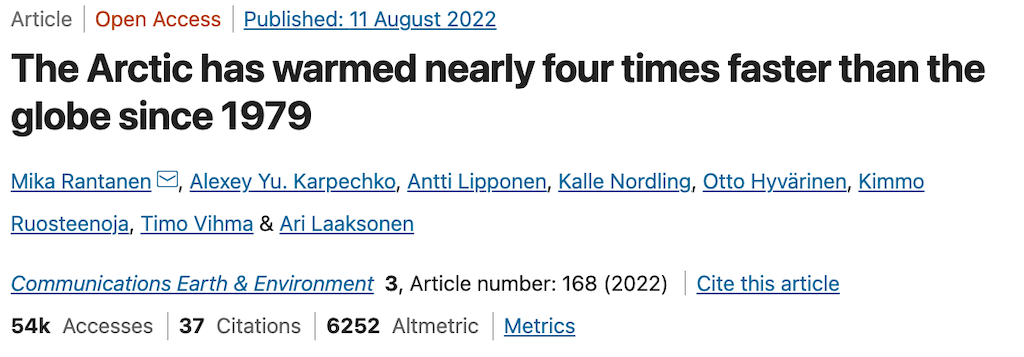
Dr Mika Rantanen – a researcher at the Finnish Meteorological Institute and lead author on the study – tells Carbon Brief that “Arctic warming and its consequences have become one of the biggest manifestations of climate change”. As such, he says he and his co-authors expected the paper to attract media attention.
True to his expectations, the article was picked up in 765 news stories from 525 outlets, including the Independent, New York Times, Scientific American and Washington Post. “I think that choosing an attractive title was one reason why the paper was picked up so widely,” Rantanen tells Carbon Brief.
Top five
In fourth place, with an Altmetric score of 6,147, is the Nature Climate Change paper, “Greenland ice sheet climate disequilibrium and committed sea level rise”.
The study finds that the “imbalance” of the Greenland ice sheet caused by global warming means it is already committed to contributing “at least” 274mm to global sea levels in future, “regardless of 21st-century climate pathways”.
The research also warned that if Greenland melt was consistently as large as the high-melt year of 2012, this would commit 782mm to sea levels, which serves as “an ominous prognosis for Greenland’s trajectory through a 21st century of warming”.
The study was picked up by 867 news stories from 658 outlets. These include, for example, a Guardian headline warning that major sea level rise from Greenland was now “inevitable”, and an Associated Press article leading on the idea of “zombie ice”:
“That’s doomed ice that, while still attached to thicker areas of ice, is no longer getting replenished by parent glaciers now receiving less snow. Without replenishment, the doomed ice is melting from climate change and will inevitably raise seas.”
Study co-author Dr William Colgan, a glaciologist at the Geological Survey of Denmark and Greenland, told the outlet:
“It’s dead ice. It’s just going to melt and disappear from the ice sheet…This ice has been consigned to the ocean, regardless of what climate (emissions) scenario we take now.”
The paper was also picked up by 37 blog posts and 1,671 tweets.
Completing the top five is another pandemic-related paper, “Over half of known human pathogenic diseases can be aggravated by climate change”, also published in Nature Climate Change.
It finds that nearly 60% of pathogen-caused diseases that affect humans have been “at some point aggravated” by climate-related “hazards”, such as warming and drought.
Specifically, the researchers identify how 375 infectious diseases around the world have been affected by a range of climatic hazards. They find that while 16% of infectious diseases have “at times” been reduced by climate hazards, there are more than 1,000 “unique pathways” by which pathogenic diseases were exacerbated by climate change.
The authors warn that these pathways are “too numerous for comprehensive societal adaptations” and say that this work highlights the “urgent need to work at the source of the problem: reducing [greenhouse gas] emissions”.
With an overall Altmetric tally of 6,079, the paper would have scored high enough to secure top spot last year. It was covered by 803 news stories from 582 outlets, 31 posts from 28 blogs, and 2,571 tweets from 2,277 users.
Top 10
Just missing out on a spot in the top five is a “perspective” paper in the Proceedings of the National Academy of Sciences, “Climate endgame: Exploring catastrophic climate change scenarios”. This less-than-cheery article on “catastrophic” outcomes of climate change was referenced in 556 news stories from 428 outlets. The BBC News coverage of the study says:
“Catastrophic climate change outcomes, including human extinction, are not being taken seriously enough by scientists, a new study says. The authors say that the consequences of more extreme warming – still on the cards if no action is taken – are ‘dangerously underexplored’. They argue that the world needs to start preparing for the possibility of what they term the ‘climate endgame’.”
With an Altmetric score of 4,807, spot number seven goes to the Advances in Atmospheric Sciences paper, “Another record: Ocean warming continues through 2021 despite La Niña conditions”.
The annual Lancet Countdown on Health and Climate Change report clocks in at number eight. The paper – under the heading “health at the mercy of fossil fuels” – was mentioned in 521 news stories from 386 outlets. In a striking summary, the report says:
“Worldwide, people are seeing their health increasingly affected by climate change amidst the compounding impacts of Covid-19 and the cost of living and energy crises; governments and companies continue to prioritise fossil fuels over a healthy future despite climate commitments; and rapid, holistic action is the only route to ensuring a just and healthy future.”
At number nine is the “brief communication” Nature Climate Change paper, “Rapid intensification of the emerging south-western North American megadrought in 2020-2021”. The study finds that the American west’s megadrought is the driest in at least 1,200 years.
The research was picked up in 1,187 new stories – more than any of the other 25 papers included here – including American publications the New York Times, the Washington Post, NBC News and NPR. The paper also topped the tables for blog post mentions, with 76.
Rounding off the top 10 climate articles of 2022 is the Nature Climate Change study, “Pronounced loss of Amazon rainforest resilience since the early 2000s”, with an Altmetric score of 4,195. This article was mentioned in 563 news stories from 434 outlets, including Carbon Brief, BBC News, the Independent, the New York Times and New Scientist.
The study finds that three-quarters of the Amazon rainforest has lost “resilience” since 2003 – making it more vulnerable to extreme events such as droughts. The work shows we are “approaching a tipping point”, the lead author of the study told journalists at a press conference.
Elsewhere in the top 25
The rest of the top 25 contains a varied mix of papers, including how agriculture and climate change are “reshaping” insect biodiversity worldwide (12th) and the discovery of a “genetically distinct and functionally isolated” population of polar bears from south-eastern Greenland (19th).
Just missing out on the top 10 is, “Global carbon budget 2022”, in 11th place. Published in the journal Earth System Science Data, the paper details the annually estimated “global carbon budget” as produced by the Global Carbon Project.
The paper’s lead author Prof Pierre Friedlingstein, chair of mathematical modelling of climate systems at the University of Exeter, co-wrote a Carbon Brief article to unpack their findings.
The latest data shows that global CO2 emissions from fossil fuels and cement increased by 1.0% in 2022, hitting a new record high of 36.6bn tonnes of CO2. This rise was “primarily driven by a strong increase in oil emissions as global travel continues to recover from the Covid-19 pandemic”, the article says, adding that “coal and gas emissions grew more slowly, though both had record emissions in 2022”.
There are several energy-related papers in the top 25. This includes a paper in 15th place from the Proceedings of the National Academy of Sciences, which finds that “corn-based ethanol in the US has failed to meet the policy’s own greenhouse gas emissions targets and negatively affected water quality, the area of land used for conservation, and other ecosystem processes”. Another is a Joule paper in 20th, which finds that “compared to continuing with a fossil fuel-based system, a rapid green energy transition is likely to result in trillions of net savings”.
The topic of public health features again in the top 25. For example, in 14th place is a Communications Earth & Environment study warning that, under 2C of warming, the exposure to dangerous heat stress “will likely increase by 50-100% across much of the tropics and increase by a factor of 3-10 in many regions throughout the mid-latitudes”.
Research into extreme weather also appears in the top 25. This includes a Nature Communications study in 18th place on the 2020 North Atlantic hurricane season – the most active on record – which finds that “human-induced climate change increased the extreme three-hourly storm rainfall rates and extreme three-day accumulated rainfall amounts…for observed storms that are at least tropical storm strength”. A Science Advances paper in 23rd place warns that climate change has already doubled the likelihood of an event capable of producing a catastrophic “megaflood” in California.
Finally, rounding out the top 25 is a Nature Geoscience study showing that the Thwaites glacier in west Antarctica has seen “sustained pulses of rapid retreat” in the past two centuries and similar pulses “are likely to occur in the near future”.
All the final scores for the top 25 climate papers of 2022 can be found in this spreadsheet.
Top journals
Across the top 25 papers in Carbon Brief’s leaderboard this year, Nature Climate Change features most frequently with four papers. Nature Climate Change also took first place in 2021 (jointly with Nature) and 2016 (jointly with Science).
In joint-second place is Nature and Science with three papers each. Nature is perennially high-placed in this analysis, taking first – or joint first – spot in Carbon Brief’s top 25 in 2021, 2020, 2019, 2018, 2017 and 2015.
For the rest of the top 25, there are four journals that appear twice and seven that appear once.
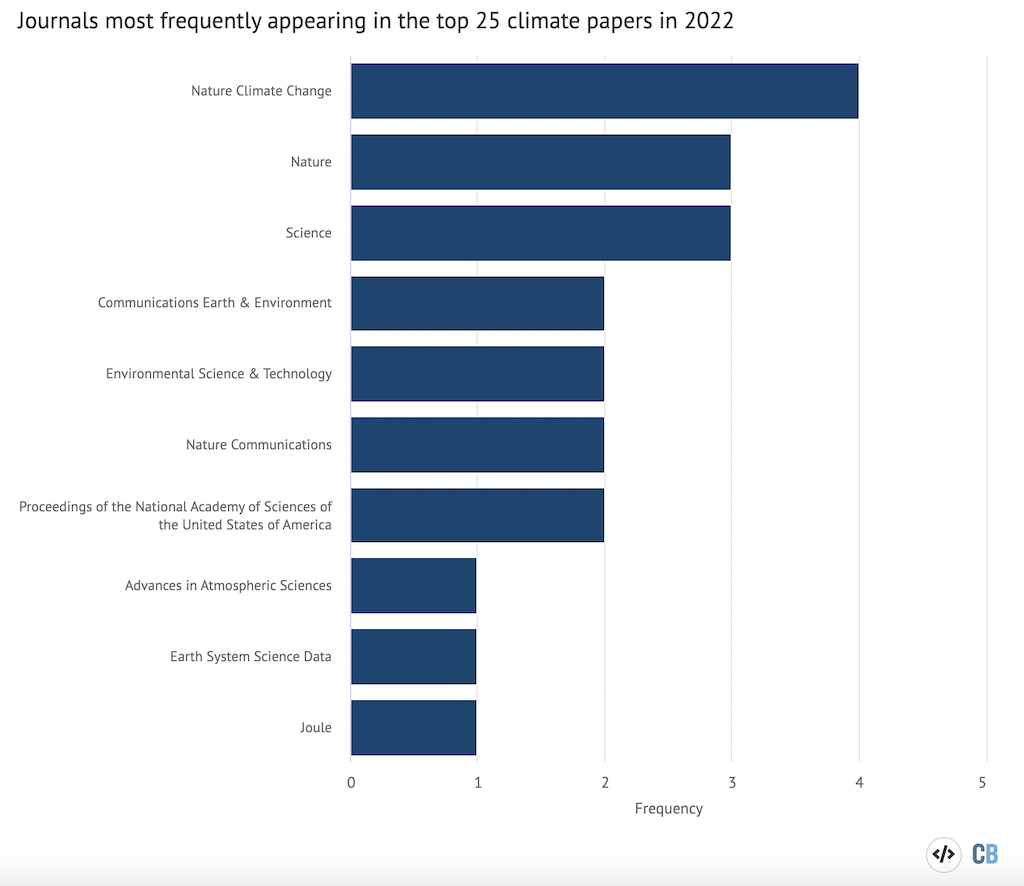
Diversity of the top 25
The top 25 climate papers of 2022 cover a huge range of topics and scope.
The “Lancet Countdown on health and climate change” and “Global Carbon Budget” reports are epic annual publications, which review vast swathes of literature and have around 100 authors each. Meanwhile, three of the climate papers in the list have only two authors, and focus on specific new frontiers of climate research.
In total, the top 25 climate papers of 2022 have more than 400 authors. However, despite the variety in the climate research the papers present, analysis of their authors reveals a distinct lack of diversity.
Carbon Brief recorded the gender and country of affiliation for each of these authors. (The methodology used was developed by Carbon Brief for analysis presented in a special 2021 series on climate justice.) The analysis reveals that the authors of the climate papers most featured in the media in 2022 are predominantly men from the global north.
The chart below shows the institutional affiliations of all authors in this analysis, broken down by continent – Europe, North America , Oceania, Asia, South America and Africa.
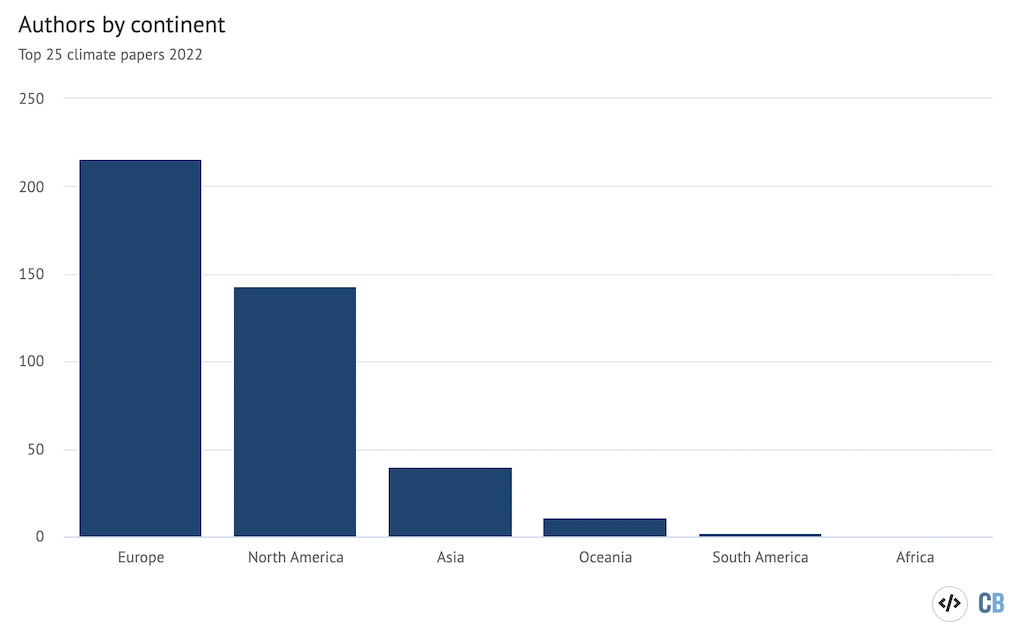
The analysis shows that nine out of every 10 authors are affiliated with institutions from the global north – defined as North America, Europe and Oceania. Meanwhile, there are only two authors from South America, based in Peru, and a single author from Africa, based in South Africa.
Further data analysis shows that there are also inequalities within continents. The map below shows the percentage of authors from each country in the analysis, where dark blue indicates a higher percentage. Countries that are not represented by any authors in the analysis are shown in white.
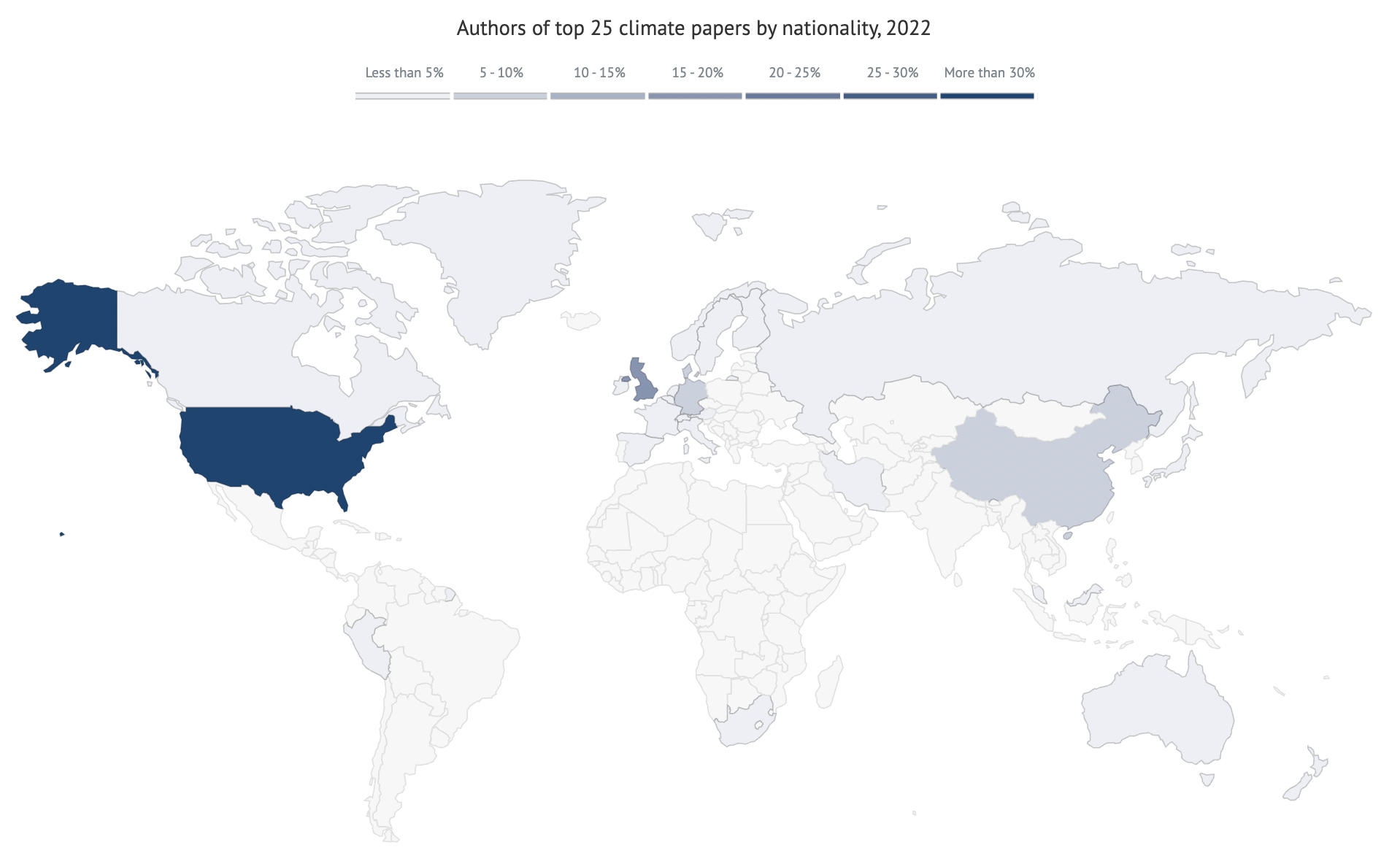
The top-ranking countries on this map are the US and the UK, which together account for more than half of all authors in this analysis (32% and 19%, respectively). Almost half of all researchers from the global south are from China – which accounts for around 6% of all researchers in the analysis.
None of the authors of the top 25 climate papers of 2022 is from south Asia, central America or the Caribbean.
Meanwhile, only 27% of authors from the top 25 climate papers of 2022 are women. Similarly, only six of the 25 papers have a female lead author.
The plot below shows the number of male (purple) and female (orange) authors in this analysis from each continent.
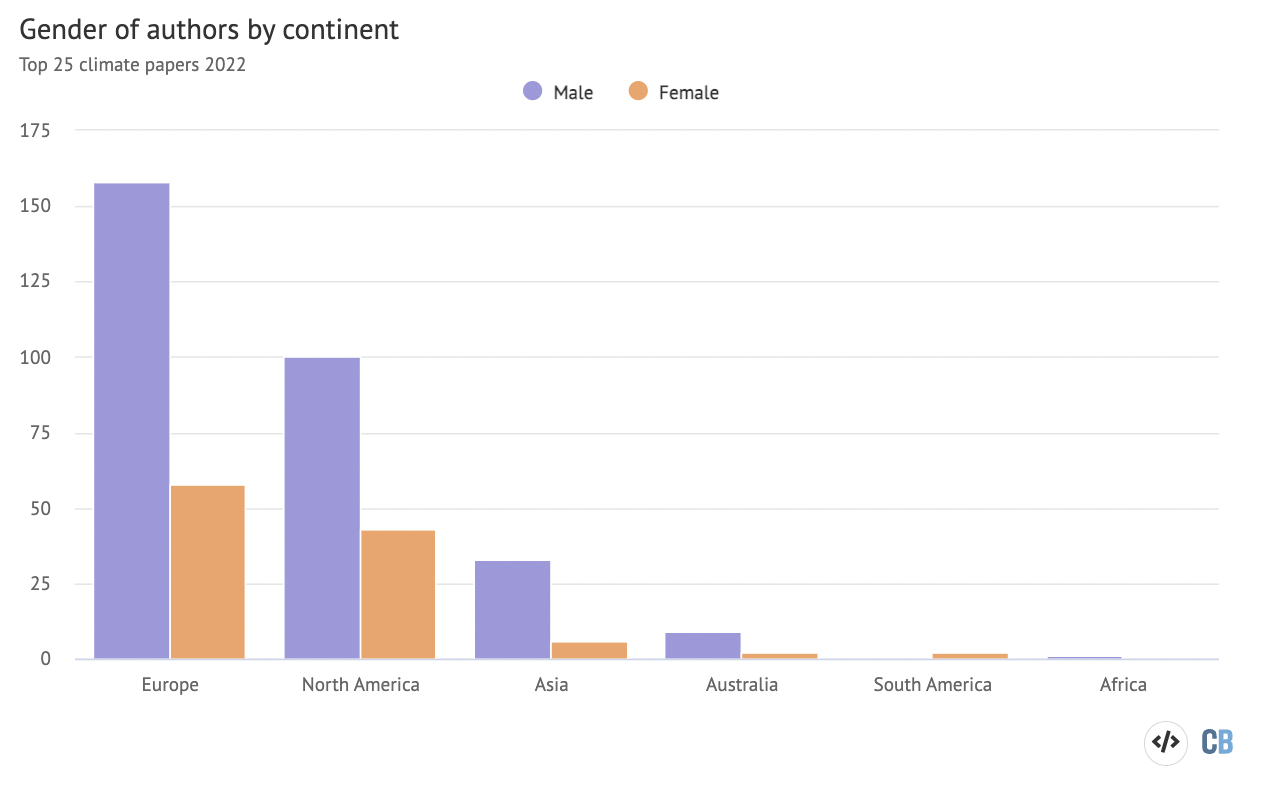
The full spreadsheet showing the results of this data analysis can be found here. For more on the biases in climate publishing, see Carbon Brief’s article on the lack of diversity in climate-science research.
Update: This article was updated on 09/01/2023 to add in the diversity analysis.





